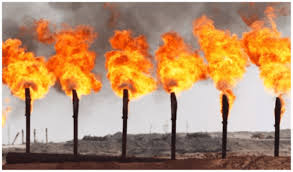
Rising gas flaring activities threaten climate change efforts – World Bank
The amount of gas flared globally in 2023 increased by nine billion cubic metres to 148 bcm, the highest level since 2019, according to a recent World Bank report.
This was stated in a World Bank statement about the Global Flaring and Methane Reduction Partnership based on new satellite data, a copy of which was obtained in Abuja on Friday.
According to the report, the increase led to an additional 23 million tonnes of emissions equivalent to carbon dioxide, which is the equivalent of adding five million cars to the road.
Demetrios Papathanasiou, Global Director of the World Bank's Energy and Extractives Global Practice, was quoted in the statement as saying: "Huge amounts of gas are still flared wastefully every year, while millions of people still lack access to basic energy and greenhouse gas emissions continue to grow."
"This wasted gas could be captured and used to generate enough power to double the amount of electricity provided in Sub-Saharan Africa, displace dirtier energy sources, and reduce greenhouse gas emissions."
The statement also cited Zubin Bamji, the World Bank's GFMR Manager, as saying that the rise in gas flaring is especially depressing because it follows a long-overdue decrease in 2022.
"This returns global gas flaring to levels observed in 2019." We hope that this is a bit of an anomaly and that significant cuts will be the longer-term pattern.
According to the study, gas flaring released dangerous pollutants that endanger human health and the environment, such as unburned methane and black carbon, which are factors in climate change.
It further stated that stopping gas flaring would prevent the annual release of at least 381 million tonnes of emissions equivalent to carbon dioxide into the atmosphere.
"Waste flared gas can help replace dirtier energy sources, increase energy access in some of the world's poorest countries, and provide much-needed energy security to many countries when used productively."
Furthermore, it said that the World Bank's yearly Global Gas Flaring Tracker Report is a tool for monitoring and understanding the state of flaring worldwide and the progress made towards achieving Zero Routine Flaring by 2030.
According to the report, estimates of global gas flaring were created by the Payne Institute at the Colorado School of Mines and the World Bank's GFMR Partnership using data from a satellite.
According to the bank, the National Oceanic and Atmospheric Administration of the United States launched and is in charge of the satellite in 2012.
"This satellite's sophisticated sensors detect the heat emitted by gas flares as infrared emissions," it continued.Governments, oil companies, and multilateral organisations make up the multi-donor trust fund known as GFMR, which is dedicated to putting an end to regular gas flaring at oil production sites worldwide.
"GFMR is dedicated to achieving nearly zero methane emissions from the oil and gas industry by 2030."





